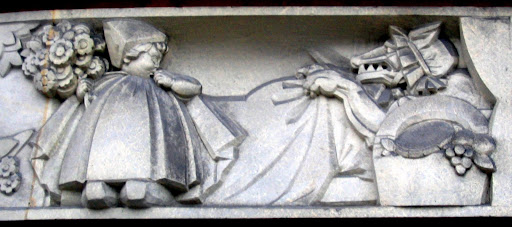Monday 22 October 2012
L'Art et L'Enfant: An Exhibition at the French National Museum of Education, Rouen
An exhibition entitled 'L'art et l'enfant: L'éducation esthétique du XIX siècle à nos jours' opened recently (19 October) at the French National Museum of Education in Rouen. It runs until 1 September 2013. It is remarkable not just for breaking new conceptual ground but also for the quality of its exhibits, extent of its vision and the subtlety of its 'voice'.
The exhibition is the brainchild of Annie Renonciat, Professor at the École normale supériore Lyon, a renowned specialist on the relationships of childhood and imagery, and a much valued contributor to the Decorated School Research Network. It illustrates, both historically and thematically, the development of the fostering of children's artistic sensibilities, talents and abilities. The first section, 'From "scribbler" to "child artist"', commences with an introduction to ideas concerning aesthetic education in eighteenth century France. Charles Hardiviller's '10 a.m. Drawing Lesson' from the 'A Day in the Life of a Young Exile' set of colour lithographs published by Alexander Hill of Edinburgh and Fonrouge of Paris in 1832 caught my eye. The section subsequently reviews the methods of modern propagators of aesthetic pedagogy from Gaston Quénioux, through Pauline Kergomard, Maria Montessori, Germaine Tortel, and Élise and Célestin Freinet, to Gérard Garouste. The large and welcome range of children's art that is examined includes, for instance, drawing, calligraphy, sculpture, ceramics, printmaking, photography and 'little hands'' needlework. The 'initiation' art encouraged by Tortel and the 'free drawing' approach of the Freinets in the mid-twentieth century were unexpected discoveries for me.
Economic, social and moral objectives for aesthetic education and the 'wrapping of children in an artistic atmosphere' are studied, with their combination coming to fore, in the section called 'Art at Home'. Ideas for 'children's rooms', plus samples of wallpapers, bedroom fabrics, toys, illustrated books and images, are displayed, these dating from the late nineteenth century on. The activities of such early twentieth century associations such as 'L'Art et l'enfant' (from 1908) and the Société des amateurs de jeux et de jouets anciens (from 1905) are revealed, alongside the products and advertisements of commercial enterprises and publishers, such as Magasins du Printemps, Grand Magasins du Louvre and Hachette. Particularly striking are the simple painted wooden nursery toys by Caran d'Ache and André Hellé (Tsar Nicholas II hunting, of 1908, by the former, and Noah's Ark, of 1910, by the latter). Also attractive are the vivacious and sensitive decorative designs, cloths and papers for children's rooms from the 1920s and 1950s. Benjamin Rabier of 'La vache qui rit' fame, stands out for the variety and strength of his artistic output for children. The superb child-centred (mainly sixties) photographs of Pierre Allard and Jean Suquet, of which the museum has a vast collection, are highly evocative and utilised with a great sense of selection.
The section of 'Art at School' begins with Jules Ferry's creation of the Commission for the Decoration of Schools and School Imagery' in 1880, looks at the initiatives of the L'Art à l'école society (established 1907), teaching through images, didactic games and illustrated puzzles, decorative designs by children (and manuals for these), the artistic design of awards and diplomas, the decoration and illustration of school books, art and the new education of the 1930s, 'the beautiful for the price of the ugly' of the fifties, and contemporary art books for children. Examples of 'decorated schools' include the following: images of the seventeenth century Chapel of the Jesuit School in Rouen; watercolour maquette drawings of the decoration of the École Normale Primaire de Chartres (1884); photographs of French Third Republic school palaces; an intriguing postcard of the study room, complete with Maurice Denis style murals of children learning in nature, at 'La Ruche - Le Patis', the 'Hive' primary school founded on libertarian principles by the anarchist Sébastien Faure near Rambouillet (Yvelines); and some refined flora and fauna-based frieze and stencil designs made in 1927 by children from the Coopératives scolaires of Saint-Jean d'Angély.
The exhibition culminates in a photographic survey of the world of the decorated school beyond France. The twenty-eight images reveal polychromatic and plastic facades, stained glass, winter gardens, murals and sculptures that embellish school institutions from Victorian Northumberland and 1900s continental Europe, to interwar Brighton, Edinburgh and Barcelona, postwar Hertfordshire and Yorkshire, and late twentieth century Australia and New Zealand. The visual articulation of distinct aesthetic and ideological purpose is represented, with connections being made to national, local and communal identity, history, literature, mathematics, religion, science, youth and, inevitably, art itself.
There is much more to this exhibition than I have time to 'report' here. I recommend visiting in person, for each vitrine, each wall and each section contains a wealth of inspiring sources for keen eyes and minds...
Subscribe to:
Posts (Atom)







